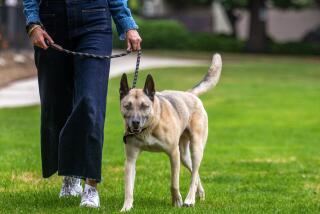Muzzling the Pit Bull
- Share via
The family dog, baseball and the Fourth of July--all part of the American dream, unless the dog happens to be a pit bull. Rarely has a dog stirred such controversy. But then pit bulls are not ordinary dogs. For years the American pit bull terrier, the Staffordshire terrier and combinations of the two (all called “pit bulls”) have been bred to fight.
The aggressive nature of these dogs has been heightened by breeding the strongest with the best--or the worst, depending on one’s viewpoint. The dogs, which weigh 35 to 65 pounds, have muscular torsos and jaws of extraordinary strength--two to three times as powerful as those of a Doberman pinscher.
Animal-control authorities say that with proper handling and breeding the aggressive nature of the dog can be restrained, but not reliably so. Even seemingly docile pit bulls may accidentally get the “taste of blood”--a taunting neighborhood cat or a teasing child. Once the dog has tasted blood, its aggressive nature surfaces, they say, and the dog is undependable at best, uncontrollable at worst.
Statistics say that pit bulls bite less frequently than some other breeds do. But, when they do, the attacks can be lethal. Since 1983, pit bulls have been responsible for 20 of 28 deaths in the nation caused by dog bites; 14 involved children under age 6. Unlike other dogs, the pit bull characteristically clamps on to its victim with jaws capable of exerting 2,000 pounds of pressure per square inch, and does not let go until the victim succumbs or the dog is confronted with superior force.
In an effort to further discourage illegal dog fighting, state Sen. David A. Roberti (D-Los Angeles) has proposed legislation (SB 1623) to elevate owner participation in dog fighting to a felony crime. The penalty would include 16 months to three years in prison and/or a $50,000 fine per violation.
On Tuesday the Los Angeles City Council passed a measure that would allow animal-control officers to impound and in some cases destroy animals that have bitten or attacked. Although this regulation is a step in the right direction, it pertains only to animals that have already attacked.
Any animal that threatens public safety should be removed from the community. But this must be tempered by the judgment of an animal-control expert who witnesses aggressive behavior or an owner’s inability to maintain control of the animal.
If a dog is initially observed as dangerous, it should be impounded by animal-control officers for further observation pending a panel hearing. The hearing would provide an opportunity for the owner to refute the charge, and an evaluation could then be made regarding the animal’s threat to the public.
George F. Baca, chief deputy director of the Los Angeles County Department of Animal Care and Control, plans to recommend such a regulation to the Board of Supervisors. We urge the supervisors to support this plan. There is no room in domestic communities for these undomesticated animals.
More to Read
Go beyond the scoreboard
Get the latest on L.A.'s teams in the daily Sports Report newsletter.
You may occasionally receive promotional content from the Los Angeles Times.










